The Intel Xeon E3-1500 V5 line is perhaps one of the more interesting chip releases in some time. Although Intel is starting to roll out Kaby Lake, the Skylake Xeon E3-1500 V5 family had one extremely interesting aspect to it, the addition of virtualization options for Citrix VDI deployments. Today we have benchmarks of the Intel Xeon E3-1515M V5 part which is a 45w TDP 4 core / 8 thread Skylake part. Thanks to the 14nm process, the Intel Xeon E3-1515M has 2.80GHz base and 3.70 Turbo clocks. If you look back just two generations to Haswell, a 3.7GHz max turbo quad-core part with 8MB L3 cache was an 80W TDP part (E3-1230 V3). Essentially only two generations later, we get a GPU and 43% lower TDP.
Test Configuration
Our test platform was not our standard platform. We did these benchmarks on a system we had in the DemoEval lab.
- CPU: Intel Xeon E3-1515M V5
- Platform: Supermicro X11SSV-M4
- SSD: Intel DC S3700 400GB
- RAM: 16GB (2x 8GB) DDR4 ECC SODIMMs
Overall, the platform is extremely compact for the amount of processing power it gives.
Intel Xeon E3-1515M V5 Benchmarks
For our testing we are using Linux-Bench scripts which help us see cross platform “least common denominator” results. We are using gcc due to its ubiquity as a default compiler. One can see details of each benchmark here. We are likely going to update the Linux-Bench in the near future with a few new tests as well as an even simpler to use/ faster revision, but for now, we are using our old Ubuntu 14.04.4 version. If you want to see example results, here is one run on Linux-Bench.
Python Linux 4.4.2 Kernel Compile Benchmark
This is one of the most requested benchmarks for STH over the past few years. We (finally) have a Linux kernel compile benchmark script that is consistent. Expect to see this functionality migrate into Linux-Bench soon (we are just awaiting the parser work on it.) The task was simple, we have a standard configuration file, the Linux 4.4.2 kernel from kernel.org, and “make” with every thread in the system. We are expressing results in terms of complies per hour to make the results easier to read.
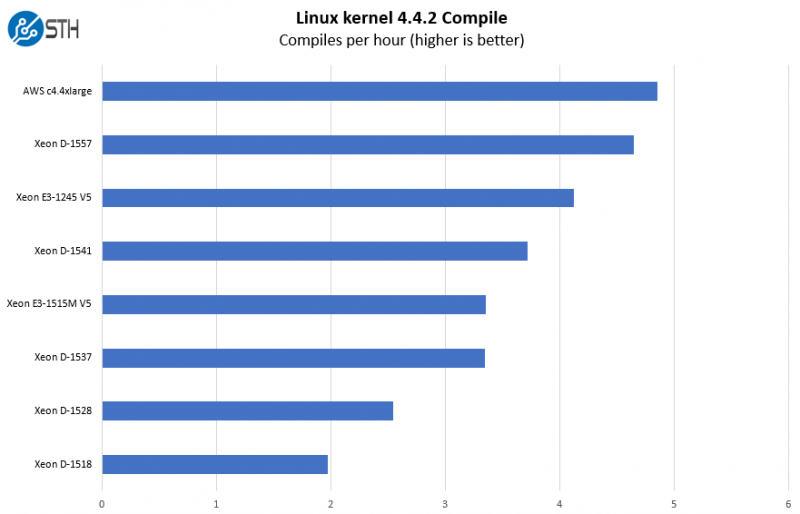
From a raw CPU compute perspective, this 45w TDP partperformed very well. Higher clock speeds helped the quad core part achieve levels just shy of some of the other Skylake Xeon E3’s we have seen.
c-ray 1.1 Performance
We have been using c-ray for our performance testing for years now. It is a ray tracing benchmark that is extremely popular to show differences in processors under multi-threaded workloads.
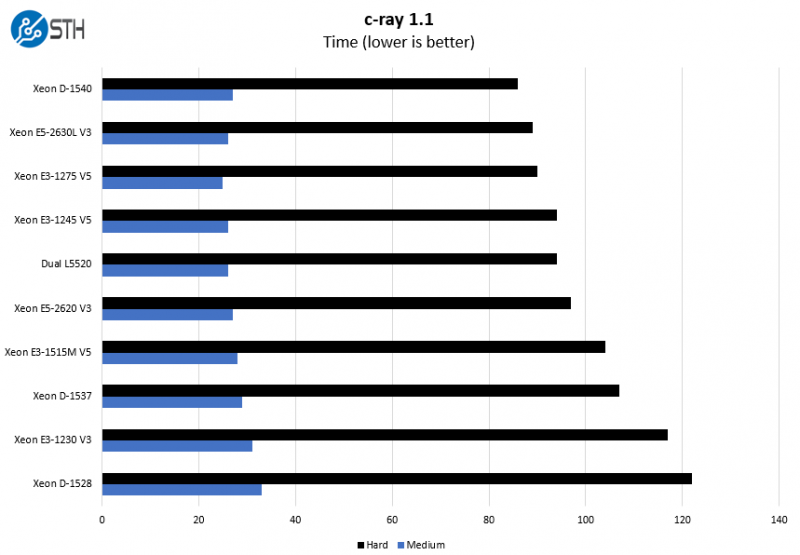
One aspect to remember here is that this is a 45w TDP CPU that is fairly competitive with the higher-TDP Xeon E3-1200 V5 offerings as well as older generation dual processor systems. That is certainly a feat considering this CPU is meant to utilize its video encoders and GVT-d/ GVT-g GPU virtualization features. Just as a reference, our fastest systems can do the “hard” 4K render in about 6 seconds now.
7-zip Performance
7-zip is a widely used compression/ decompression program that works cross platform. We started using the program during our early days with Windows testing. It is now part of Linux-Bench.
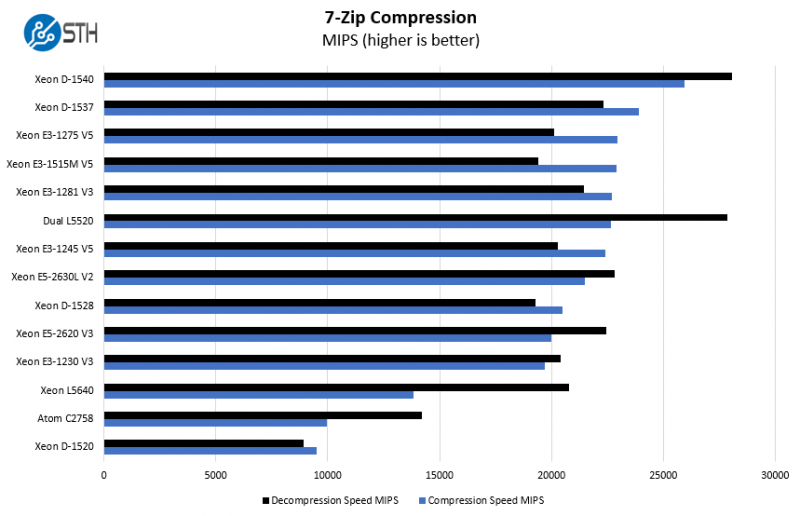
We are using a fairly wide comparison set here to show where the Intel Xeon E3-1515M V5 falls and the chart is sorted on compression speeds. Here you can see that the processor is just about where we would expect a four core and higher clock speed part to fall.
NAMD Performance
NAMD is a molecular modeling benchmark developed by the Theoretical and Computational Biophysics Group at the Beckman Institute for Advanced Science and Technology at the University of Illinois at Urbana-Champaign. More information on the benchmark can be found here.
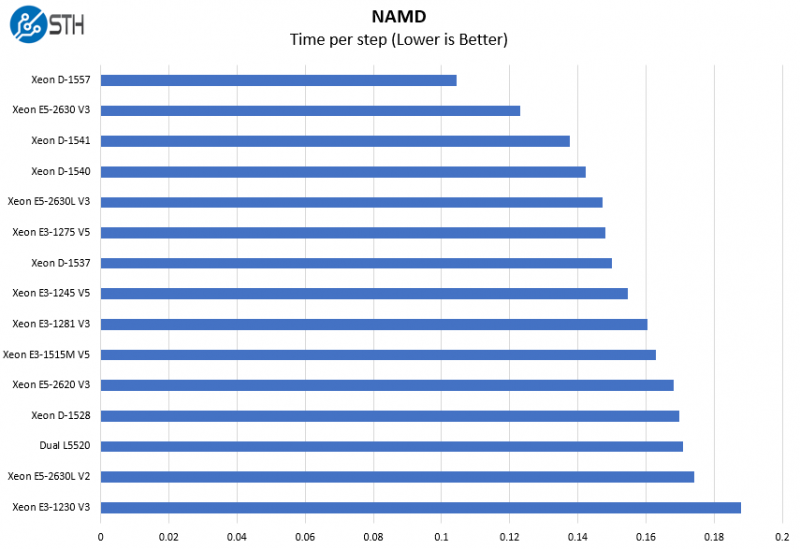
If you are using the Intel Xeon E3-1515M V5 to do molecular modeling, that is likely a sub-optimal use case. We did just want to show this as one of our standard benchmarks.
Sysbench CPU test
Sysbench is another one of those widely used Linux benchmarks. We specifically are using the CPU test, not the OLTP test that we use for some storage testing.
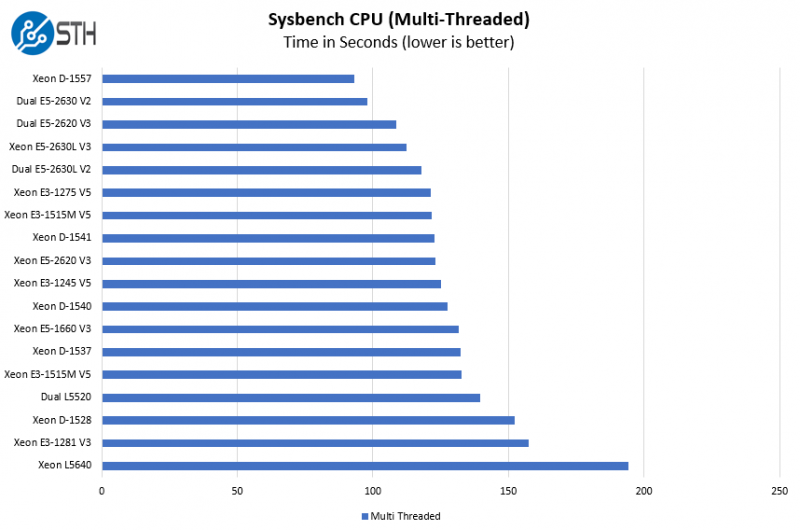
Again, we can see a very strong performance here from a low power part. We included the Westmere-EP generation L5640 here to show what a single socket 60W TDP part would look like from several years ago.
OpenSSL Performance
OpenSSL is widely used to secure communications between servers. This is an important protocol in many server stacks. We first look at our sign tests:
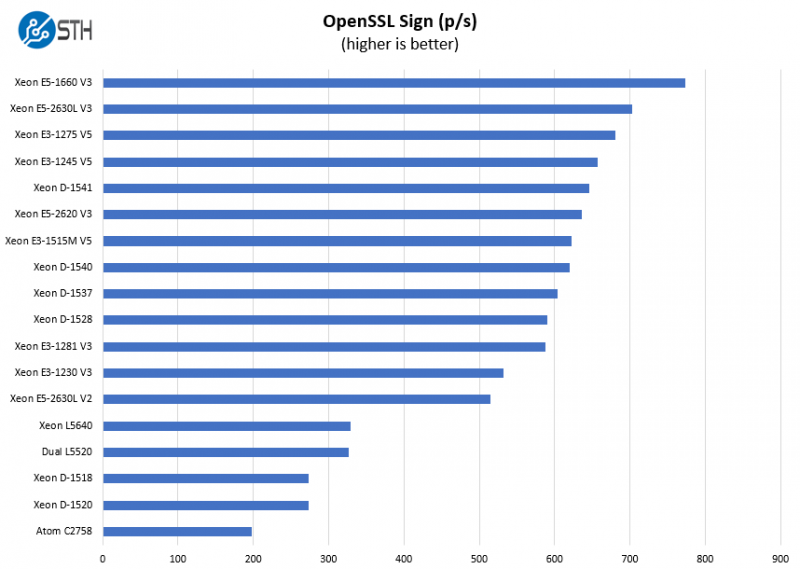
Moving to the verify results:
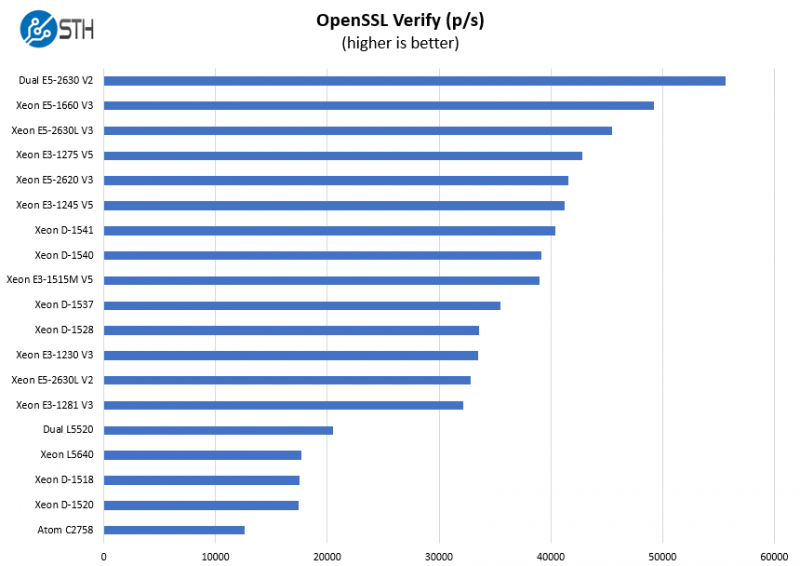
We do see these results as in-line with expectations for the 45W TDP part.
UnixBench Dhrystone 2 and Whetstone Benchmarks
Of course, these chips are not meant for heavy compute but we pick out the UnixBench 5.1.3 Dhrystone 2 and Whetstone results to show some of the raw performance they are capable of. UnixBench is widely used so it is a good comparison point.
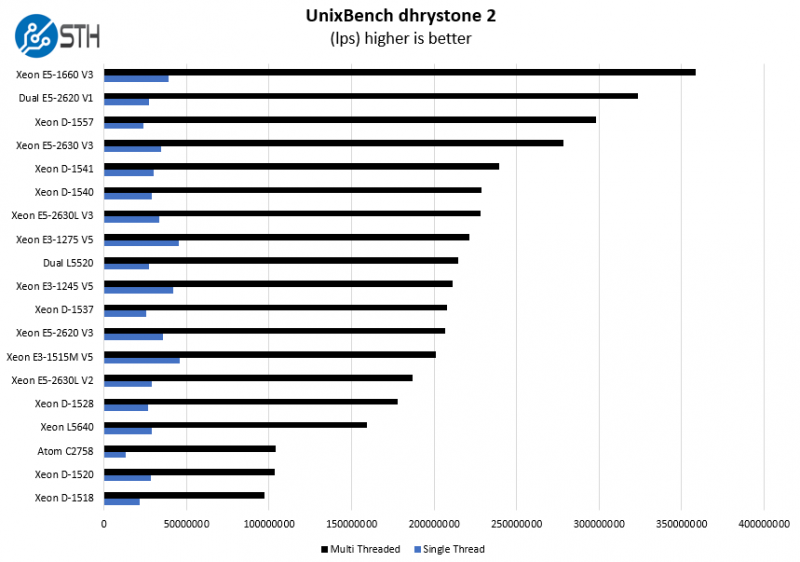
As we increase the core counts the multi-threaded performance dominates the chart scale. In single-threaded benchmarks the Intel Xeon E3-1515M V5 does perform extremely well.
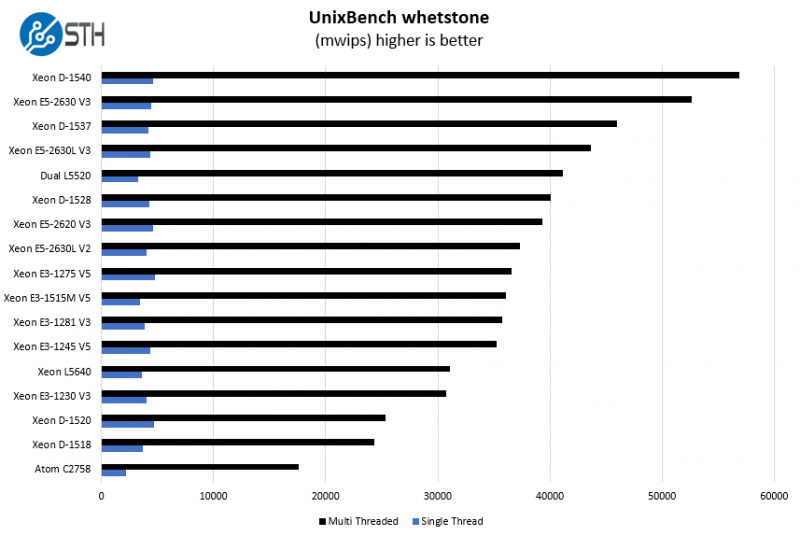
Multi-threaded performance was above the 80W TDP, sans GPU, Xeon E3-1230 V3 from just two generations ago which is impressive.
Conclusion
Overall, the CPU performance on the Intel Xeon E3-1515M is extremely impressive given its 45w TDP. We are going to have platform power consumption figures in our upcoming X11SSV-M4 motherboard review. With that said, those who need Quick Sync video transcoding or the Citrix VDI capabilities of this platform are likely the ones who will be the most interested in its performance.

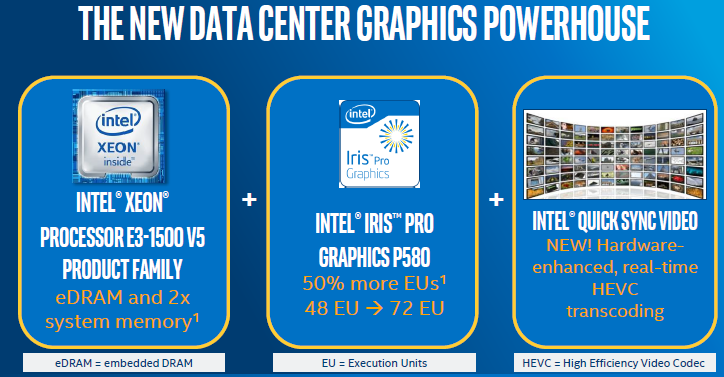



I have to say it again, why not use Phoronix Test Suite for comprehensive Linux benchmarking, which also works on current distributions?
This review ignores one of the most powerful features of this chip: It has the full-bore Iris Pro 580 graphics with on-package eDRAM. That makes these parts extremely useful in many applications that can take advantage of the integrated graphics, and I’m not talking about games here.
Any chance there will be a review of the E3 1585 v5? I’ve been really curious to see how a 3.5/3.9 quad-core with eDRAM fares against the regular consumer chips (6700k/etc.)
“If you look back just two generations to Haswell, a 3.7GHz max turbo quad-core part with 8MB L3 cache was an 80W TDP part (E3-1230 V3). Essentially only two generations later, we get a GPU and 43% lower TDP.”
Comparing a lot TDP CPU to a high TDP CPU hardly seems fair. Comparing the E3-1515M V5 to the E3-1275L V3 shows the Haswell generation processor to have the same TDP, 100 MHz lower base clock (2.8 GHz vs 2.7 GHz for V3), 200 MHz higher turbo clock (3.7 GHz vs 3.9 GHz for V3), and the E3-1275L V3 has an integrated GPU.
The E3-1515M V5 MSRP is $489 vs the E3-1230 V3 MSRP @ $250, and the E3-1275L v3 MSRP at $328.
It seems in two generations we have gained a bigger GPU and $150 in price. CPU’s seem to be getting more boring every year.
Great content otherwise, as always!
The E3-1275L V3 did not have eDRAM and was quite a different chip, but point taken. The other major difference is that the E3-1200 series is socketed.
If we get a platform with one we will.